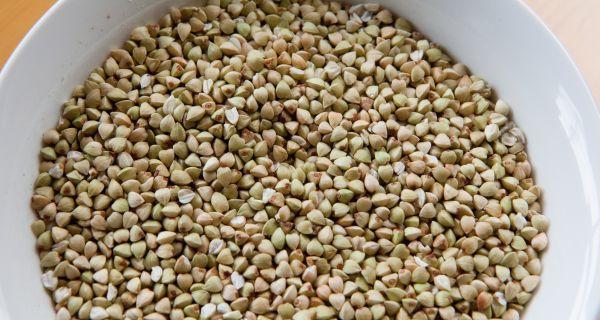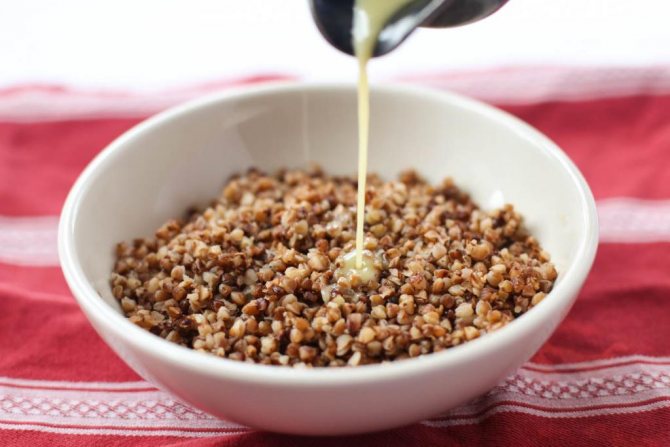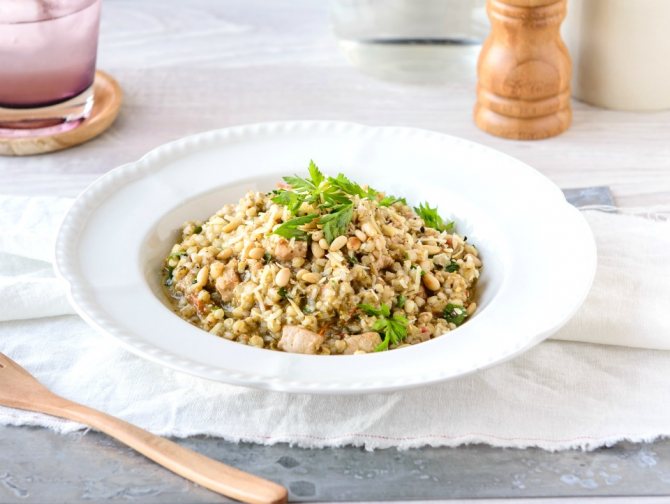Ideal product during lactation
This cereal is great for nursing women.
It does not provoke allergic reactions and has many beneficial qualities. Therefore, experts recommend that young mothers include this product in their diet. Buckwheat during breastfeeding helps increase the concentration of iron in the blood, improves the condition of the skin, hair and dental tissue. However, you should not abuse such cereals. In addition, in the first months of lactation it is not recommended to combine it with milk.
Can buckwheat be harmful?
Buckwheat is considered one of the most hypoallergenic and safe cereals. When growing it, no herbicides or other chemicals are used, because buckwheat itself displaces weeds from the field.
An allergy to buckwheat in an infant is an extremely rare phenomenon. As a rule, it is well accepted by babies and does not cause digestive problems. Usually, buckwheat does not cause negative reactions even among allergy sufferers, so mothers of such children often have to go on a buckwheat diet, excluding more dangerous cereals from the menu.
It is not recommended for nursing mothers to use buckwheat for weight loss, as a mono-diet. The period of breastfeeding is generally not suitable for strict and not very strict diets, since they are poorly adapted to the requirement to eat a nutritious and balanced diet.
DETAILS: Is it possible to eat mackerel on a diet or not?
Despite all the beneficial properties, a nursing mother should first consult with a doctor about introducing the product into the diet if:
- food allergies and individual intolerances;
- chronic renal and liver failure;
- stomach and duodenal ulcers;
- exacerbation of gastritis or pancreatitis;
- increased blood clotting.
Useful qualities of the product
So, the answer to the question of whether buckwheat can be consumed while breastfeeding or not is certainly positive. This cereal is considered part of a healthy diet for women during lactation. She has many positive qualities. Buckwheat has the following benefits:
- Does not contain allergens and gluten. That is why experts recommend that women consume this type of cereal already in the first months of lactation.
- The product is quickly absorbed. All the beneficial compounds it contains easily enter the body.
- During the growing process, buckwheat is not treated with harmful substances.
- The cereal contains a large amount of iron. It prevents the development of anemia in women who have recently given birth.
- The product contains calcium, which has a beneficial effect on the condition of the skin, bones, nail plates, dental tissue and hair.
- The cereal contains B vitamins, organic acids, as well as other useful substances: boron, phosphorus, zinc, iodine. These microelements participate in metabolic processes, normalize myocardial functions, and remove excess cholesterol from body cells.
- The product helps to cope with gastrointestinal disorders (constipation, bloating). Such phenomena are often observed after delivery.
- Cereals support good functioning of the liver, immune system, vision and hematopoiesis.
- The product promotes rapid saturation. Thanks to this property, a young mother can get rid of the extra pounds that she gained during pregnancy.
- Cereals are useful for the absorption of vitamin C. Therefore, a woman is recommended to consume foods containing this substance along with porridge.
- Buckwheat helps normalize blood pressure, eliminates problems with the heart and blood vessels.
- Cereals help maintain normal blood glucose concentrations. It serves as an excellent prevention of diabetes.
How is buckwheat beneficial for a baby during breastfeeding? The substances contained in the porridge quickly enter the baby’s body due to the fact that the product is easily digestible. Cereals help strengthen the baby’s immune system and normalize the functioning of the central nervous system.
The role of buckwheat in normalizing hormonal levels
It is known that during pregnancy and lactation, a woman’s body undergoes significant changes. Many new mothers face problems such as depression and anxiety.

These phenomena are explained by hormonal imbalance. Due to its high magnesium content, buckwheat during breastfeeding helps stabilize the nervous system and normalizes the emotional state. Regular use of the product helps eliminate insomnia, depressed mood, irritability and anxiety.
Important points to consider when choosing cereals
Experts recommend including buckwheat in the diet during breastfeeding in the first month of lactation. In addition, it is useful for infants under one year of age as complementary foods. However, when choosing a product, you need to pay attention to the following aspects:
- Shelf life. You need to give preference to the freshest buckwheat.
- Product quality.

Good cereal has smooth edges that do not differ in color. - Green buckwheat is the healthiest type of porridge when breastfeeding. It does not undergo heat treatment and therefore retains all its positive qualities. However, such cereals are quite expensive. If it is not possible to buy this product, experts advise purchasing kernels. Prodel is the least useful option. It consists of crushed grains and contains few vitamins.
Features of introducing cereals into the diet
Buckwheat during breastfeeding, as a rule, does not provoke allergies in infants. Despite the safety of the product, it should be included in the diet of a young mother with extreme caution. In the first month of lactation, you should consume a small amount of cereal. Indeed, at this time, the baby’s gastrointestinal tract organs have not yet fully adapted to the external environment. Therefore, porridge can provoke digestive dysfunction. For the first time, a young mother should limit herself to two large spoons of cereal. After lactation, you need to monitor the baby’s condition. In the absence of colic, stool disorders and flatulence, the amount of product can be increased. If problems with the gastrointestinal tract occur, the introduction of porridge into the diet should be postponed for about 2 months. Probably, by this time the baby’s digestive organs will already be sufficiently formed, and buckwheat will not cause negative reactions. Experts advise gradually increasing the dose of the product to 150 grams per day.
buckwheat diet for breastfeeding
Even 11 years ago, I was an ardent defender of breastfeeding and did not at all understand the girls who said that I would feed with formula, that there was not enough milk, that the baby did not want to breastfeed, etc. It seemed to me that behind such “excuses” there was only a reluctance to breastfeed and love for oneself, and not for the child.
I nursed my now 11-year-old daughter until she was 2.5 years old, and that’s what happened.
When I was expecting my second child, I didn’t think much about breastfeeding; I knew that breastfeeding was the best thing for a child - both useful and convenient. Of course, I didn’t intend to feed until 2.5 years old, but until 1.5 years old it’s easy.
Well, well, then from the series “if you want to make God laugh, tell us about your plans.”
Now the youngest daughter is 5 months old. From about 1 month we began to experience terrible redness of the butt, leading to ulcers. The doctors said that I was eating something wrong, and although I stuck to a diet (buckwheat, beef, zucchini, etc.), they told me to better watch my diet and cut out dairy for up to 3 months. I started following a diet, but my daughter’s butt still wasn’t healing. We’ve already taken the medications (Enterofuril, Linex), but it’s better not to get better. And I’m still on a diet, losing the kilos I’ve acquired, which I don’t have much of anyway (height 162, weight 47 kg).
My mother is already starting to swear at me and tries in every possible way to persuade me to switch to formula, saying that you are torturing yourself and the child. The dermatologist shrugs, prescribes all sorts of ointments and also suggests switching to a mixture. The pediatrician says to wait until 3 months and everything will pass.
And lo and behold, at about 3 months, as if by magic, our long-suffering little butt became clean and pink, just like there were no sores or praises!
Hooray!!! It would seem that life has improved, you can safely continue breastfeeding, start eating normally. BUT!
Now another misfortune appears.

And the spot continued to grow, new spots were added on the other leg and back. We're going to the dermatologist. We ask - allergies? She says - No, it’s like that for all children. And he prescribes Redecil ointment. Well, we’ve been applying it for 2 weeks, but there’s no point.
We went to another doctor and prescribed Suprastin, a hormonal ointment.

We take Zyrtec for 10 days and apply hormonal cream.
Well, I go on a diet, 2 weeks pass, and the spots become smaller and then larger. It’s already starting to seem to me that I have a reaction to zucchini, then to rice, oh, I exclude them, but it doesn’t get any better. And the third week of the diet has already begun, but the spots do not go away. In the morning they turn pale, and by evening they are red and rough, as if they were rubbed with sandpaper. I’m already 42 kg, my mother continues to reproach me - you’ve given up on this breastfeeding, what’s the point of it, you’re only harming yourself and the baby. I'm holding on for now. The doctor said that the mixture is difficult to choose, and the reaction may also not be good. But I myself think, maybe I’m all in vain, maybe I really should have switched to formula and my daughter will feel better!?
Slowly we need to introduce complementary foods, but I can’t, because... The spots get better, then new ones appear. It didn’t even take a couple of days for my feet to be clean. It only got better when I took medicine.
The 4th week of the strict diet ends, but there is no improvement 

Or maybe I should really switch to formula, what if I am the cause of my daughter’s allergies? After all, is there breast milk intolerance?
Something like this!
Signature: no longer a zealous defender of GW.
Precautionary measures
Eating buckwheat with milk while breastfeeding is not recommended until the baby is twelve months old. Before this, cereals can only be cooked in water. Butter should also not be added.

Lactose, which is part of dairy products, can cause dysfunction of the digestive system in a child. In the first months of breastfeeding, experts advise consuming green buckwheat. At a later period, you can add dried fruits to the porridge (if there are no problems with the gastrointestinal tract or allergies in the baby). It is better to avoid granulated sugar. It contributes to the appearance of flatulence in a child.
Features of cooking food
There are many recipes that include this product. Not all of them are suitable for women during lactation. When preparing buckwheat while breastfeeding, you need to pay attention to the following aspects:
- First of all, the grains must be thoroughly washed. Water removes harmful compounds from the surface of the cereal. They can negatively affect the health of mother and baby. Unopened grains should be discarded.
- Then the moisture is removed from the cereal. Place the grains in a heated frying pan and fry over medium heat for five minutes. Stir occasionally to prevent the product from burning. This cooking method allows you to make the food appetizing and crumbly.
- Then the grains are placed in a saucepan and filled with cold water. The volume of liquid should be two to three times the amount of cereal. Add a little salt to the vessel and put it on the fire, after closing the lid. Bring to a boil. Cook the porridge until it absorbs all the moisture. The heat can be reduced to prevent the product from burning.
- Then the cereal is cooled for fifteen minutes. Open the lid and stir the dish.
During breastfeeding, buckwheat can be consumed as a side dish for meat and fish dishes, and chicken.

It is also used to make soup. The first course of such cereals does not have a significant effect on the lactation process and the amount of milk. However, it is nutritious and benefits both mother and baby. The soup is made from buckwheat with the addition of vegetables (fresh or frozen). Low-fat meats are also included in the dish.
Menu for breastfeeding
| Day of the week | Breakfast | Snack | Dinner | Snack | Dinner |
| Mon | Oatmeal with apple and raisins | Green pear varieties | Seafood soup, whole grain bread | Walnuts | Steamed cutlets, salad: cucumbers, greens |
| VT | Buckwheat with milk | Whole grain bread, hard cheese | Homemade noodle and chicken soup | Rusks with raisins | Kefir |
| SR | Wheat porridge, vegetable stew (zucchini, eggplant, pepper, onion, carrot) | Baked apple, biscuits | Meatball soup | Gooseberries, cherries | Boiled fish with broccoli |
| Thu | Steam omelette, toast with cheese and herbs | Marshmallow | Buckwheat soup with beef, baked zucchini with cheese | Fruit and berry salad | Stewed cauliflower on veal |
| PT | Cottage cheese with berries | Walnuts | Chicken bouillon | Crackers | Rabbit baked in low-fat kefir, stewed vegetables |
| SB | Protein pancakes with minced meat | Kefir | Vegetable cream soup | Baked cheesecakes | Boiled chicken, lentils |
| Sun | Quail eggs, vegetable salad | Yogurt | Wheat porridge and turkey fillet soup | Bananas | Steamed meatballs, vegetables |
Cereal-based diet
Is it possible for a young mother who would like to lose excess weight to eat buckwheat while breastfeeding a newborn? Experts answer this question in the affirmative. A diet based on this product helps to get rid of the extra pounds that a woman has gained during pregnancy. In addition, a diet that includes cereals will not harm the baby. Reviews from young mothers indicate that this nutrition system helped them lose from five to nine kg of excess weight in 14 days. However, a nursing woman's diet should be balanced. And it should not be observed for more than two weeks. This diet consists of cereals steamed with boiling water. In addition to porridge, the menu includes green apples and low-fat kefir. A woman should drink up to two liters of still water daily. You should also remember that to get rid of excess pounds you need physical activity and training.
Is it possible to lose weight while breastfeeding?
Many mothers of newborns lose weight while breastfeeding and very quickly get into prenatal shape. This means that they spend more energy than enters their body with food. The second group of women rapidly gain weight while breastfeeding, which is why losing weight while breastfeeding becomes task No. 1. Why is this happening? There are several reasons:
- Postpartum depression. The body did not have time to recover, come to its senses, and a hormonal surge hit it. A sudden change leads to despondency and bad mood. A breastfed woman begins to eat flour and sweets for depression.
- Glucose requirement. After childbirth, physical activity increases greatly, and the most accessible source of fast energy is glucose. From sugar, sweets, and baked goods, this energy substance enters the blood almost instantly. When a breastfed woman overeats, her figure quickly deteriorates.
If you control your appetite, then in a month even with breastfeeding you can lose a lot of weight, because the life of a young mother is very active. Losing weight while breastfeeding should be based on the principles of proper nutrition and moderate fitness. It is important to create a varied menu and eat often so as not to feel hungry. Weight gain will slow down, and the weight loss process will get off the ground.
Features of nutrition during lactation
Experts do not recommend starting a buckwheat diet while breastfeeding in the first 30 days of lactation. It should not be considered as the only way to combat excess weight. In order not to provoke deterioration in well-being, vitamin deficiency and health problems in the baby, doctors recommend giving preference to a healthy and balanced diet.

Food must contain all the substances necessary for the normal functioning of the body. During lactation, you need to be careful when choosing foods. In general, artificial additives, colors, preservatives, and GMOs should be avoided.
Physical activity while breastfeeding
During intense training, lactic acid accumulates in the muscles, which passes into breast milk. This may cause the child to refuse breastfeeding. Exercise immediately after your baby eats or 1.5 hours before the process. The best types of physical activity while breastfeeding:
- Walking. When walking with your baby, do not sit still, but walk at a fast pace for at least 40 minutes.
- Yoga. All asanas are performed smoothly, thanks to which fatigue will go away quickly and will be replaced by relaxation.
- Swimming. Excellent tonic and uplifting. Replaces wraps, which are not recommended during lactation. Eliminates cellulite, tightens skin, ensures healthy weight loss.
- Natural loads. Little children love to jump on a fitball with their mother, fly on their hands, and dance. Be physically active with your baby.
DETAILS: LCHF diet for weight loss: menu for the week, reviews and results - minus 10 kg easily











